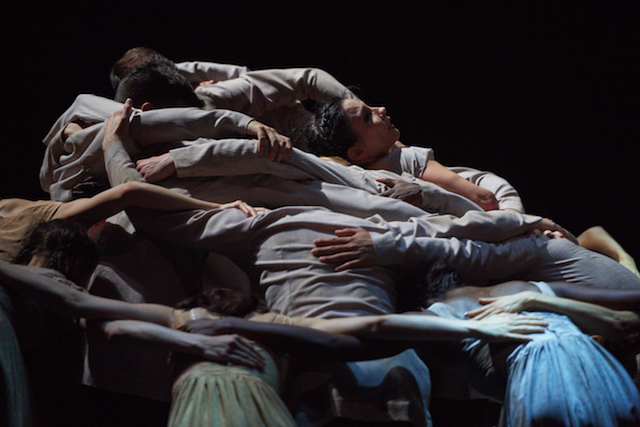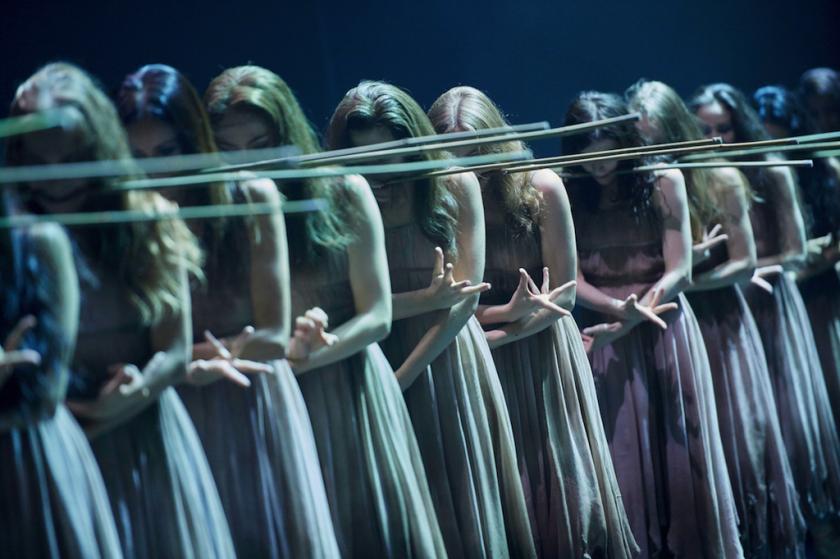Of the many good reasons for seeing Akram Khan’s 2016 remake of Giselle – his work is often a headline event, for one – the most compelling is the company performing it. English National Ballet used to be the poor relation of its plusher sister national flagship in WC2. Not any more. Under the leadership of the fabulous Tamara Rojo (formerly a major attraction at that plush national flagship) it has been transformed from a troupe of also-rans into a company of demons.
"Demonic" is the only word for the ferocious energy and precision with which ENB’s dancers deliver Khan's extraordinary feat of re-imagination. It can’t strictly be called a radical reimagining because the original story is still clearly discernible, albeit displaced, and even wisps of the old Adolphe Adam score are retained, which will please those who like something to hum on the way home. But it’s pleasingly thorough in identifying and recasting the most compelling features of the 1841 storyline – the focus on a spirited young woman whose optimism and love of dancing threatens the status quo, the terrible consequences of that optimism, and retributive justice. Where Giselle Mark 1 was a tale of forelock-tugging European peasantry crushed by the local aristocracy, Khan’s Giselle is that of a horde of rootless migrant workers, locked out by fatcat factory landlords. Vincenzo Lamagna’s score – for live orchestra meshed with pre-recorded sounds – establishes the change of scene, the change of century, in the first few seconds with its ominous grindings and rumblings cut with Asian accents of drums and ankle bells. Tim Yip’s stage design is a vast pitted wall which variously comes to represent a national boundary, a citadel, the limits of a giant factory – whichever, it’s efficient at keeping the great unwashed out. The opening shows a massed line of bodies ceaselessly, hopelessly pushing at it. Khan’s revision of the story hinges on the plight of low-paid workers in the global textile industry, whose economic fluctuations led whole communities to abandon rural lives – whether in Lancashire or Bangladesh – only to be left high and dry when the factories closed and investment moved elsewhere.
Vincenzo Lamagna’s score – for live orchestra meshed with pre-recorded sounds – establishes the change of scene, the change of century, in the first few seconds with its ominous grindings and rumblings cut with Asian accents of drums and ankle bells. Tim Yip’s stage design is a vast pitted wall which variously comes to represent a national boundary, a citadel, the limits of a giant factory – whichever, it’s efficient at keeping the great unwashed out. The opening shows a massed line of bodies ceaselessly, hopelessly pushing at it. Khan’s revision of the story hinges on the plight of low-paid workers in the global textile industry, whose economic fluctuations led whole communities to abandon rural lives – whether in Lancashire or Bangladesh – only to be left high and dry when the factories closed and investment moved elsewhere.
Giselle is part of this outcast community; Albrecht, unknown to her, is the scion of an industry magnate. Hilarion, who also loves her, is a fast-moving wheeler-dealer who slips between both worlds and has every reason to betray his rival’s secret. The scenario is clever all right, but the greater achievement is the clarity of Khan’s storytelling in the midst of thrilling massed movement. He has clearly made a close study of past masters, Pina Bausch most obviously, but he gives the work a personal stamp by drawing on shapes and poses from his own dance heritage, kathak, in temple-dome arms and cactus-spike fingers. He even manages to incorporate salient features from mid-19th century ballet – the fast, beaten jumps, the arabesque – without jarring. This is a migrant community with a wide-ranging folk memory.
This Queen of the Wilis issues her threats by means of what can only be described as an intensity of quivering
It would be something of a spoiler to describe how Khan reproduces the spook-factor of the original second act, in which the so-called wilis, the ghosts of betrayed young girls, hunt down passing men and take their revenge. Let’s just say he matches it, surpasses it even. The person behind me was audibly enthralled, and quietly sobbed throughout the final minutes. Khan’s Giselle goes far beyond the love story: it’s also a wake-up call to the plight of the world’s disposessed, and just like Bathilde, Albrecht’s fiancée, we are all almost certainly wearing a piece of their wretched labour on our backs.
Tamara Rojo led the cast on opening night with a passionate authority, with James Streeter a winning Albrecht and Cesar Corrales a hyper-athletic Hilarion. Stina Quagebeur made a particularly terrifying Myrtha, Queen of the Wilis. I’ve rarely witnessed such dramatic power from a dancer who barely moves from the spot, issuing her threats by means of what can only be described as an intensity of quivering.
Casts will change, but the two biggest stars of the night will not. One of them is the ENB Philharmonic conducted by the tireless Gavin Sutherland. It’s no fun working to a click-track in a hot dark pit, but the result of their efforts is stunning. The other star turn is the corps de ballet with their Olympic stamina and fiendish unison attack, demons indeed.














Add comment